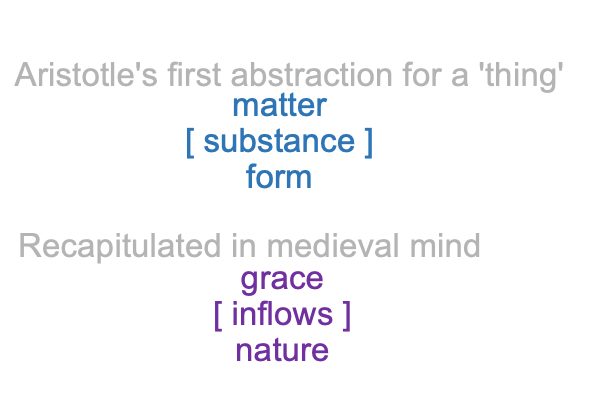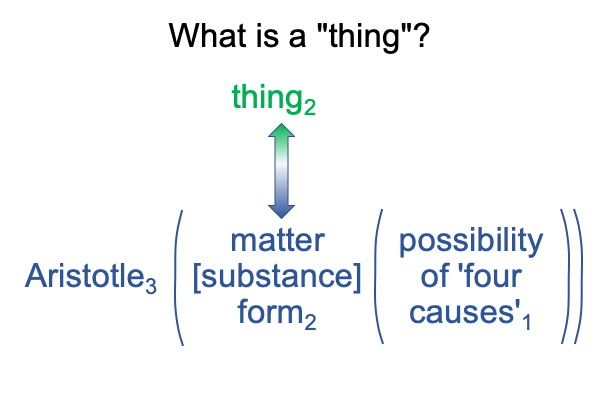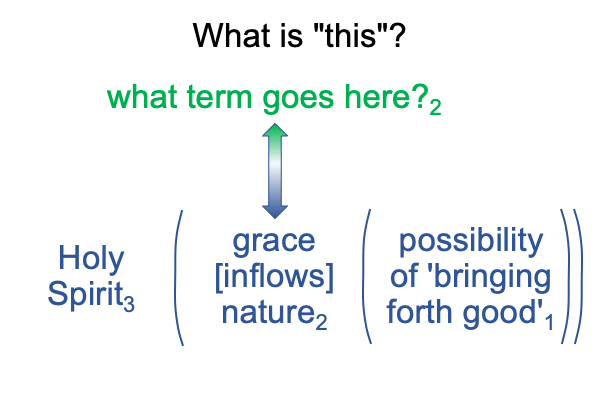0038 Inerrancy is tied to dual revelation. Two aspects of one reality are revealed. At the start, these two aspects are grace and nature.
0039 The philosophy of Charles Peirce enters here. He proposes three categories: firstness, secondness and thirdness. The category-based nested form contains all three categories.
Here, I want to drill down on secondness. Secondness contains two contiguous real elements. For Aristotle’s hylomorphe, the two real elements are matter and form. The contiguity is placed in brackets for proper notation. What word describes the contiguity between matter and form? I choose the much abused term, “substance”. A thing is matter [substance] form.
0040 Now, scholastics of the early medieval period (say, in the centuries leading to and including the founding of universities in Europe) express a theological hylomorphe that complements Aristotle’s hylomorphe.
Here is a picture.

0041 Of course, a modern may object that “grace” is not like matter because it is not material.
However, in reply, I note that “grace” is being, which stands at one end of a spectrum between relationality and materiality. I could have written the following, “A purely relational being [substantiates] a natural form.”
Oh, the objections do not stop there.
The same modern may object that “nature” is not susceptible to immaterial, purely relational beings.
To which I reply, “Sign-relations are purely relational beings and creatures in nature are always dealing with signs. Indeed, biologist Jakob von Uexkull comes up with a technical word for any living creature’s world of significance. The term is ‘Umwelt’. Yeah, the noun is capitalized in German. Each noun is like an an-Noun-cement.”
0042 Now, I ask, “Why does Aristotle offer his hylomorphe as the first step in natural philosophy?”
Here is the answer, as far as I can see.

The normal context of Aristotle’s philosophy3 brings the actuality of the hylomorphe, matter [substance] form2, into relation with the potential of the material, efficient, formal and final causes1.
A person encounters a thing. An inquirer may understand this thing2, starting with matter [substance] form2. Understanding provides a normal context3 and potential1.
0043 Now I ask, “Why do the early schoolmen offer their hylomorphe as the first step in bringing the revelations of the Old and New Testaments into harmony with the rationality of Greek philosophy?”
Obviously, the revelations of the Old and New Testaments enter into Greek natural reasonings and redeem them. The revelations of Jerusalem bring Greek philosophy to life.
0044 Okay, when I want to understand how grace [inflows] nature2, I place this hylomorphe into a normal context3 and a potential1.
How do I do this?
I take a guess.

Yes, that is a reasonable guess.
0045 However, this guess leads to another question, asking, “If grace2 is like matter2 and nature2 is like shape2, then what label do I put for the equivalent to Aristotle’s ‘thing’2, given the normal context3 of the Holy Spirit3 and the potential for ‘bringing forth good’1?”
Perhaps, the human as an image of God?
Well, whatever the label may be, it is not scientific.
